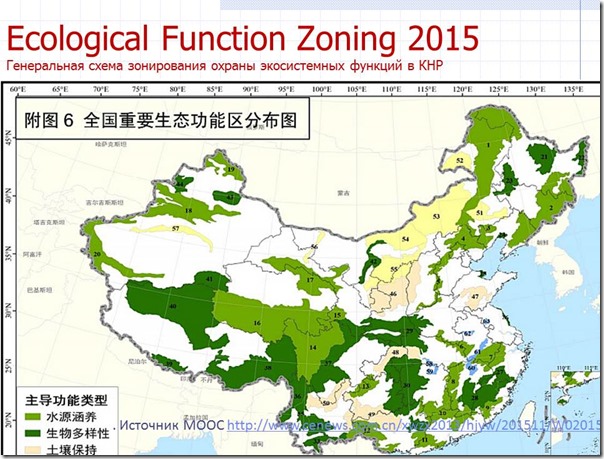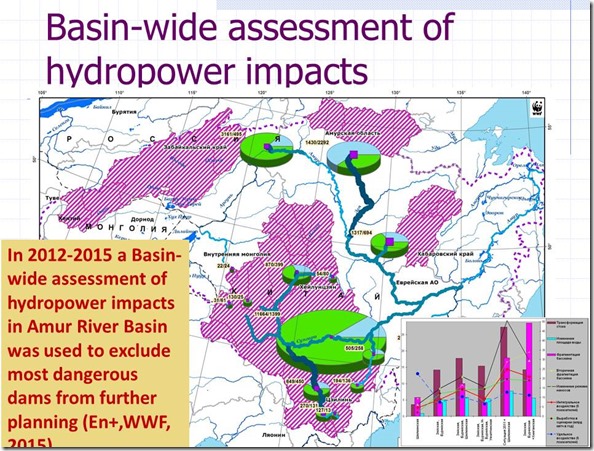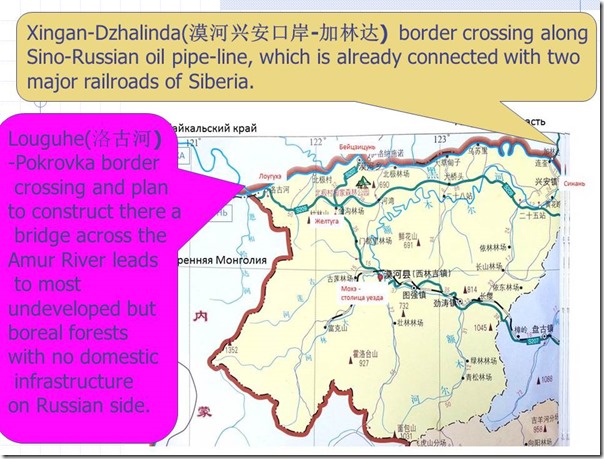RwB’s International Coordinator Eugene Simonov on March 5 took part in the 2016 Annual Meeting of Heilongjiang Provincial Association for Northeast Asian Studies/ in Harbin City. Environmental Section of the Meeting gathered members of the Amur-Okhotsk Consortium from Japan, Mongolia, China and Russia. Dr. Simonov summarized most important environmental precautions that should be taken in conjunction with the Chinese New Silk Road Initiative. Below we publish his short report titled “Some Environmental Issues on the Silk Road”
I) Ecological Civilization and the Silk Road
In 2015 by issuing the "Integrated Reform Plan for Promoting Ecological Progress" the State Council of China announced new development path not tried out by other nations. This domestic policy states that to build a "Beautiful China", handle correctly the relationship between humankind and nature, and solve serious ecological and environmental problems, it is essential to safeguard China’s ecological security, improve the environment, ensure that resources are used more efficiently, and step up efforts to promote the formation of a new pattern of modernization in which humankind develops in harmony with nature [1]. Various aspects of the plan, such as delineation and protection of "ecosystem function zones" are already underway in pilot regions, and the whole governance system should be adjusted before 2020 to reflect environmental requirements.
If successful in a long term this development path will serve as important lesson to all neighboring nations, but at the same time in a short term stricter environmental policies within China may lead to massive flux of "dirty" and resource-intensive technologies to adjacent countries. Similar migration from the countries of West has happened in the past during their "post -industrial" modernization and is widely considered as a pattern of unsustainable development that should be consciously avoided when designing international policies. In previous decade Russia has experience influx of resource-extraction industries from China, which contributed to increasing imbalanced development of regions near Sino-Russian Border. In some sectors, like forestry, increased resource extraction in Russia was often seen as facilitating implementation of important domestic environmental policies in China, such as logging bans [2].
Whether the new "Ecological civilization policy" will bring strengthening of international environmental standards or contribute to environmental pollution in neighboring countries very much depends on implementation of another major new policy of China known as the "One Belt, One Road"(OBOR). In March 2015 NDRC and two other lead agencies published a detailed document "Vision and Actions on Jointly Building Silk Road Economic Belt and 21st-Century Maritime Silk Road", that seeks to explain proposed mode of integration between China and other countries of Eurasia. The OBOR Initiative "aims to promote the connectivity of Asian, European and African continents and their adjacent seas, establish and strengthen partnerships among the countries, set up all-dimensional, multi-tiered and composite connectivity networks, and realize diversified, independent, balanced and sustainable development in these countries. It promotes practical cooperation in all fields, and works to build a community of shared interests, destiny and responsibility featuring mutual political trust, economic integration and cultural inclusiveness."[3]. Presently NDRC is coordinating setting various international standards that can guide practical implementation of the OBOR policy. Simultaneous with OBOR there are other emerging integration initiatives such as Steppe Road (promoted by Mongolia), Eurasian Economic Union (championed by Russia) and several other multi-country development platforms. This adds complexity to the task of coordination and standardization in Eurasia.
II) Silk Road Initiative Lacks Operational Environmental Standards
From environmental perspective the "Vision" document already contains many important key-words on "ecological progress in conducting investment and trade, increased cooperation in conserving eco-environment, protecting biodiversity, and tackling climate change, and joining hands to make the Silk Road an environment-friendly one". However, while it has clear description of basic financial, infrastructure, trade and cultural policies to be used in OBOR, the document does not contain any clear structured policy guidance on ways to advance "green development", ensure environmental sustainability, establish environmental safeguards to prevent negative impacts from new infrastructure and industrial facilities. This sphere is left without systemic guidance, likely leaving the task of tackling environmental issues to various responsible agencies and bilateral agreements. However, historically China agencies do not have a strong record of controlling environmental performance of Chinese companies overseas, leaving that to host countries. For example, although Chinese Ministry of Commerce and Ministry of Environmental Protection have jointly issued the Guidelines for Environmental Protection of Foreign Investment and Cooperation , it has no compulsory force over Chinese enterprises making foreign investment so far, and enterprises are only encouraged and guided to fulfill their social environmental responsibilities [4] [5]. 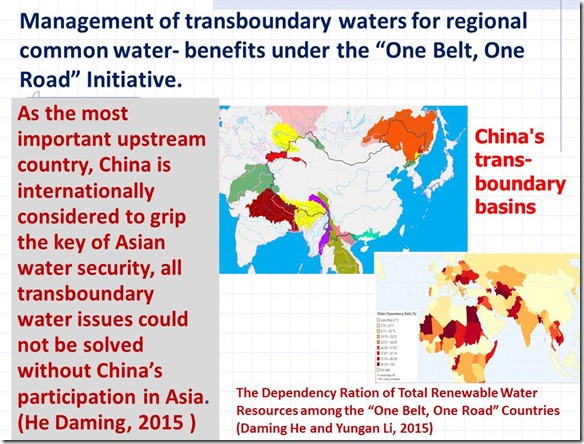
Nevertheless it is quite obvious that such massive and comprehensive international development initiative as OBOR cannot be successfully carried out without having a clear set of environmental standards and safeguards and public participation mechanisms making the effort credible in the eyes of civil society in host countries and globally. For example, our Rivers without Boundaries international coalition (RwB) argued at the Seventh Session of the Meeting of the Parties to the UNECE Water Convention in 2015 that " The civil society of Eurasian countries see an urgent need for the Silk Belt and other Eurasian integration initiatives to adopt advanced environmental and social standards and policies, develop public participation mechanisms and subscribe to safeguards in transboundary water management. Without such safeguards risks of this new integration for environment and local communities may be very high. There is an urgent need to ensure protection of river and lake ecosystems and promoting green development and ecosystem-based climate adaptation policies within the framework of Eurasian integration efforts."[6]. Therefore in this paper I want to name some commonly-recognized policy tools and existing international instruments, that could be readily used in OBOR cooperation to ensure sustainability and safeguarding ecological environment.
III) Readily Available UNECE Mechanisms
Using mechanisms of existing UNECE environmental conventions could become the most beneficial "shortcut" for setting common standards for the OBOR initiative. Silk Road is by definition a road to Europe and many countries on this road already belong to jurisdiction of UNECE and have signed or use mechanisms of an array of environmental conventions most of which successfully function for more than 20 years. Majority of UNECE members and convention parties are actively participating in new Eurasian integration initiatives: planning megaprojects, co-founding investment banks, coordinating spatial planning schemes, building energy networks, etc. From recently UNECE environmental conventions are open for joining to non-UNECE countries and many Asian countries have already expressed interest. The UNECE environmental conventions could serve as a ready source of tested environmental safeguard mechanisms that could be used in new Eurasian integration programs. Those are:
· Convention on the Protection and Use of Transboundary Watercourses and International Lakes
· Convention on Environmental Impact Assessment in a Transboundary Context (Espoo) and the Protocol on Strategic Environmental Assessment (Kiev)
· Convention on the Transboundary Effects of Industrial Accidents
· Convention on Long-range Transboundary Air Pollution
New development and integration programs along the Silk Road will result in increasing utilization of water resources and diverse impacts on transboundary rivers. China, having 17 large river basins shared with neighbors, and through OBOR entering space with at least another 30 transboundary basins, should be interested in using tested mechanisms already shared by many of its partners on the Silk Road. Thus utilizing the UNECE Water Convention is a high priority.
China’s objective to jointly build a green Silk Road will not be achieved without the strategic environmental assessment and environmental impact assessment tools in a transboundary context. Thus Espoo Convention and Kiev Protocol on Strategic Environmental Assessment may provide important commonly used tool for OBOR countries. Most countries of Eastern and Western Europe as well as members of the Eurasian Economic Union – Kazakhstan, Kyrgyzstan, Belarus, and Armenia – have already become parties to the Espoo Convention. The Espoo Convention and the SEA protocol are open for accession to countries outside of the UN Economic Commission for Europe’s area of responsibility, and signing this instrument that has already proven its worth is the best and the fastest way to ensure environmental safety of the Silk Road [7].
Strategic Environmental Assessment is particularly valuable tool when it comes to design and transboundary coordination of various spatial planning mechanisms, a high priority task for China and its neighbors for example in:
– Comprehensive development planning in adjacent regions and common basins [8];
– Assessment of basin-wide hydropower development schemes [9]
– Planning transboundary protected areas networks and other conservation measures [10]
IV) Developing and Preserving Connectivity through Ecological Networks.
The protected areas network example is especially relevant in the context of Silk Road Initiative, because it emphasizes connectivity and promotes development of transportation, industrial, communication and trade networks. Doing so the OBOR core policies should incorporate an explicit objective to preserve and reinforce natural ecological connectivity through development of international ecological network [11]. Russia and China explicitly recognized such necessity in 2011 signing the "Sino-Russian strategy for development of transboundary protected rea network in Amur River basin"(中俄黑龙江流域自然保护区网络建设战略)[12].Now it is time to join forces with international expert bodies such as IUCN and UNESCO and extend this effort to the whole Eurasia as one of the most necessary safeguards on the Silk Road.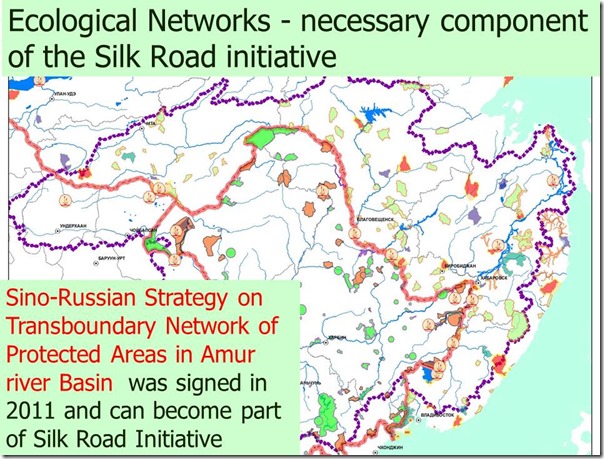
Lack of SEA and other coordination tools in spatial planning may lead to costly mistakes, which may also bear serious negative environmental and social consequences. For example, there is a push to re-open a Sino-Russian Louguhe(洛古河)-Pokrovka border crossing and even construct there a bridge across the Amur River in Mohe county of Heilongjiang Province. This was often presented in media and conferences as "an element of OBOR transportation route". However, in reality this proposed bridge leads to most undeveloped but fragile boreal forest region on Russian side, where no domestic infrastructure exists to justify bridge construction. A road and bridge built at Louguhe will dissect two nature reserves and open to exploitation last old-growth forests that safeguard now Amur and Argun transboundary rivers. This will decrease connectivity between natural boreal forest ecosystems in Russia and China. 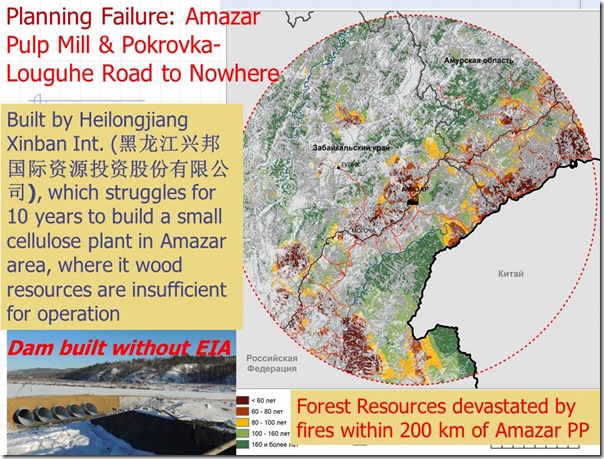
This construction has been for long lobbied by Heilongjiang Xingbang International (黑龙江兴邦国际资源投资股份有限公司) company, which struggles for 10 years to build a small cellulose plant in the area, where it lacks wood resources for operation due to rampant forest fires. Recent report by the President’s Council on Civil Society Development and Human Rights in Russian Federation suggests that this enterprise cannot be sustainable [13]. Meanwhile transportation network analysis shows that in the same Mohe County there it is possible to reopen Xingan-Dzhalinda(漠河兴安口岸–加林达) border crossing along Sino-Russian oil pipe-line, which is readily connected with two major railroads of Siberia. Expected negative environmental impact from bridging two riverbanks there is much lower and potential systemic benefits for trade and transportation are likely to be much higher. Strategic environmental assessment could be readily used to compare these two and other potential interconnections and choose most beneficial option.
Another area in need of shared OBOR policies, joint planning and SEA is climate adaptation, especially ecosystem-based climate adaptation, which is extremely hot topic for countries that comprise the Silk Road space. Absence of such common tools and planning processes nowadays leads to major losses and even conflicts [14] [15] [16].
V) Unifying Environmental and Social Investment Standards and Safeguards.
According to WWF, the concept of “Jointly Building Silk Road Economic Belt” and related requirements, includes highlighting the concept of ecological civilization in investment and trade, and strengthening cooperation on ecological environment, biodiversity and addressing climate change. While encouraging enterprises to participate in infrastructure construction and industrial investment of countries along the Belt and Road, the Initiative clearly states enterprises should bear social responsibilities positively and strictly comply with the requirements for protecting biodiversity and ecological environment, and a number of key environmental protection projects are also planned [4]. However in OBOR setting no single institution or policy-making committee overseas this process. The problem is that beyond its own internal CSR policies (which may be minimal) behavior of individual company is dependent only on the environmental and social requirements set forth by the lending institution, which is not necessarily the most reliable mechanism.
In the case of the Asian Infrastructure Investment Bank this function should be fulfilled by use of the Environmental and Social Framework (ESF). This policy guidelines, yet to be tested, in 2015 has been subject of heated discussion between the AIIB Interim Secretariat and international civil society. Many NGOs from 20 OBOR countries claimed that ESF has not been designed with sufficient detail and was not subjected to due public consultation process conducted in national languages in AIIB member-countries. Although consultation process was clearly insufficient, ESF has been slightly improved in the course of this discussion and now is approved and awaits its first trial [17].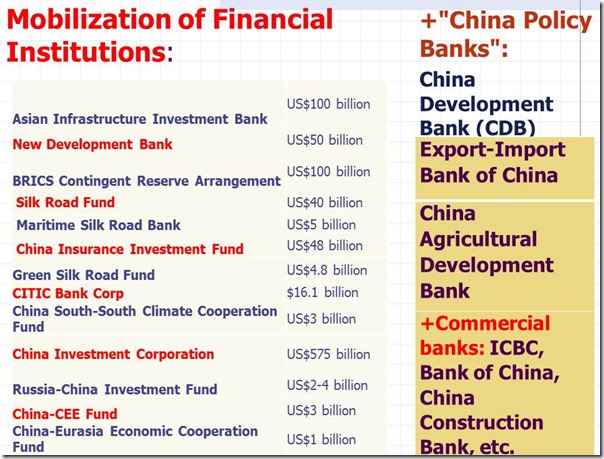
However, multilateral AIIB is a flagship institution for OBOR financing and is at focus of global attention. Therefore it is forced to adopt high standards comparable to those developed by the World Bank and other Bretton-Woods institutions under pressure from civil society. But besides AIIB enormous investment resources exceeding 1 trillion dollars are prepared by more than 20 investment institutions to support OBOR initiatives, some of them brand-new as Silk Road Fund and some rather old like China’s "policy banks" (e.g.China Development Bank or China EXIM Bank). Some financial institutions are multilateral or bilateral, but the majority has been established unilaterally by China government. Environmental and social frameworks developed by most of these institutions are not available to population of OBOR countries in national languages of even English. Many of them lack public participation and grievance procedures and most of them do not publicize results of environmental and social assessments done for funded projects. This creates real problem for project oversight both from state entities and civil society.
Civil society groups of OBOR countries are not very mature, often are oppressed by governments and lack resources for its activities [18]. Therefore it will take considerable time before it develops capability to trace and prevent incidents of environmental destruction and social injustice happening due to uncontrolled activities of the multitude of institutions financing OBOR elements.-. This lack of both internal standards and civil society control for individual projects presents a serious threat to successful implementation of the OBOR policies and achieving its harmonious objectives.
One of measures that could significantly improve the situation and reduce risks for all investments would be unifying minimal environmental and social requirements and criteria for all project investments made in OBOR countries and supplementing that with strong green development policy that seeks to explicitly harmonize "Ecological civilization development" inside Chine with Silk Road Initiative directed at neighbors. Then new domestic and international policies will reinforce each other and lead to sustainable development in Eurasian continent.
Cited documents:
1. Integrated Reform Plan for Promoting Ecological Progress. State Council of China. http://www.china.org.cn/china/Off_the_Wire/2015-09/21/content_36644574.htm
2. Evgeny Simonov, Evgeny Shvarts and Lada Progunova editors. Environmental Risks to Sino-Russian Transboundary Cooperation: from “Brown” Plans to a “Green” Strategy. 200 pp. WWF-Russia. Moscow. 2010 (in Russian) 2012 (in English) http://www.wwf.ru/resources/publ/book/eng/440,
3. NDRC Vision and Actions on Jointly Building Silk Road Economic Belt and 21st-Century Maritime Silk Road http://en.ndrc.gov.cn/newsrelease/201503/t20150330_669367.html
4. WWF. 区域开发机构环境与社会管理框架国际经验研究. 2015. http://www.wwfchina.org/content/press/publication/2015
5. Chinese Ministry of Commerce and Ministry of Environmental Protection. Guidelines for Environmental Protection of Foreign Investment and Cooperation.
6. Silk Belt and in need of Water Convention. Intervention at the Seventh session of the Meeting of the Parties to the Water Convention is being held in Budapest on 17 November 2015. https://www.transrivers.org/2015/1587/
7. Evgeny Simonov and Evgeny Shvarts. Pure Growth Vitamins (Витамины чистого роста) BRICS Magazine. http://bricsmagazine.com/en/articles/pure-growth-vitamins
8. Simonov Eugene, Dahmer Thomas. Amur-Heilong River Basin Reader. 450p. published by Ecosystems LTD in Hongkong.2008 .(in English) http://www.wwf.ru/resources/publ/book/299.
9. Basin-wide environmental assessment of hydropower development scenarios. рр 16-106 and 253-279. in Comprehensive environmental and socio-economic assessment of hydropower development in the Amur river basin. – WWF-Russia,Evrosibenergo,EN+Group. 279 pp. In Russian, 2015. http://www.wwf.ru/resources/news/article/13534
10. Darman, E.Simonov. E.Egidarev. Transboundary Protected areas network as environmental management tool. pp150-154 in [2]
11. Darman Y., Simonov E. Amur Heilong Ecoregion conservation program as a platform for Bio-Bridge initiative. 2015 Northeast Asia Peace and Cooperation Initiative Forum: New Horizons for Multilateral Cooperation in Northeast Asia, 27-29 October 2015. Seoul, 2015, P.163-167.
12. Российско-Китайская Стратегия создания трансграничной сети особо охраняемых природных территорий бассейна реки Амур (《中俄黑龙江流域自然保护区网络建设战略》.2011 ). Приложение 4 к Протоколу шестого заседания Подкомиссии по сотрудничеству в области охраны окружающей среды Российско-Китайской комиссии по подготовке регулярных встреч глав правительств. Харбин, КНР. 02.06.2011. 24 с. http://news.xinhuanet.com/world/2011-06/02/c_13908170_2.htm
13. President’s Council on Civil Society Development and Human Rights in Russian Federation. Recommendations Resulting from Council’s Session in Zabaikalsky Region December 14-18, 2015. http://president-sovet.ru/presscenter/news/read/2988/
14. Kirilyuk O., editor, 2012. ADAPTATION TO CLIMATE CHANGE IN RIVER BASINS OF DAURIA: ECOLOGY AND WATER MANAGEMENT. (in Russian) 180pp, Express Publishing House, Chita, Russia,2012. https://www.transrivers.org/2013/814/
15. Transboundary Flood Management in Amur River Basin..pp.45-49 in UNECE and WMO. Report of the Second Workshop on Transboundary Flood Risk Management. March 2015.( published by UNECE in July 2015) http://www.unece.org/fileadmin/DAM/env/documents/2015/WAT/03Mar_19-20_Geneva/UNECE-Floods-conference_report_FINAL_26-06-2015.pdf
16. Dauria Going Dry: adaptation to climate change in transboundary headwaters of the Amur River Basin 2015. https://www2.unece.org/ehlm/platform/display/ClimateChange/Dauria+going+dry
17. Asian Infrastructure Investment Bank. Environmental and Social Framework (ESF): http://www.aiib.org/uploadfile/2016/0226/20160226043633542.pdf
18. Eugene Simonov. Role of Civil Society Organizations in Conservation of the Amur River Basin and the North Pacific Rim. The 3rd INTERNATIONAL MEETING OF THE AMUR-OKHOTSK CONSORTIUM Vladivostok, Russia October 07–08, 2013 http://amurokhotsk.com/wp-content/uploads/2014/08/3rd-AOC-proceedings-2.pdf


